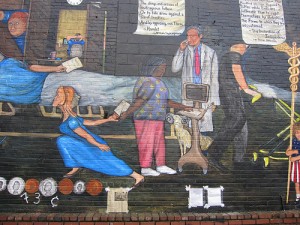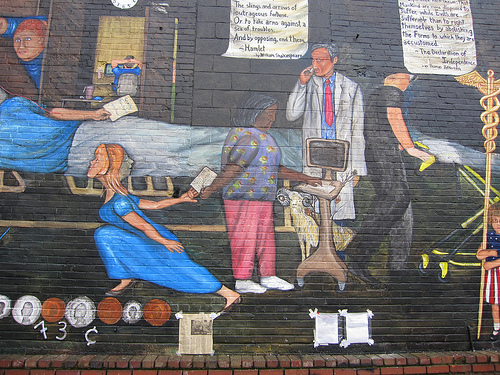
Regina Holliday was at work teaching art when she got a call from her husband, Fred. The doctor had just told him he had growths and tumors in his kidneys. She rushed to the hospital to process the news with him and understand the diagnosis. Before she got there, Fred’s oncologist had left for a 4-day medical conference. Fred had kidney cancer and would die within months, but neither he nor Regina knew that because Fred was transferred to another medical facility and was not given a proper diagnosis nor his medical records for the next doctor to use. When Regina went to claim Fred’s records, she found they would cost 73 cents a page to print (they were several hundred pages), with a 21-day wait. When they did get copies, the records were inaccurate and incomplete. Frustrated by a lack of information from medical providers and the U.S. health care system, Regina reached out to her friend who suggested she talk to a patient advocate on Twitter, @ePatientDave, a stage-four kidney cancer survivor. Through Dave and other friends, Regina got answers and connected to the health advocacy community online. An artist, Regina painted a mural in DC about her ordeal, called 73 cents, which she promoted on Twitter, Facebook, and her blog. Soon CNN, BBC, CBS, and other traditional national news media picked up her story and she became part of the national health care debate in May 2009.
Regina did not know what Twitter was when she received the phone call from Fred in the hospital. However, she took a chance and with one tweet made connections to health advocacy groups she would never have found otherwise.
Twitter, Facebook, and blogs are tools that can amplify the message and build the network of any peacebuilder. Many of these tools even let you send messages from email or your mobile phone, so you do not always need a fast internet connection to use them. Your stories and ideas can spread to the right people further and faster than ever before. Here are a few tips to get you started:
- Create a Twitter account: You can follow interesting people and talk to them using special characters in your messages. You can even send messages called tweets using your mobile phone texting service.
- Create a Facebook account: Either for yourself personally or your organization (to create an organization account, you will need to first create a personal account). You can add friends you already know, post pictures, videos, and stories to share with other people.
- Start a blog: There are many free services, and I suggest Blogger, WordPress, or Posterous. You do not need to spend a lot of time or know much about technology. Just write a few articles about what you are passionate about and tell your friends and colleagues about it.
The world needs to hear your stories. In July 2010, a year after Fred passed away, Regina got a standing ovation for her speech at the Health Information Technology conference, on a stage with the U.S. Secretary of Health and Human Services. How far can your story go if you use these social media tools?
You can learn more about Regina Holliday’s story in The Big Book of Social Media Case Studies, Stories, Perspectives by Robert Fine. Her mural, “73 cents,” is located at 5001 Connecticut Ave, Washington, DC 20008.
 [Roxy Allen (MA ’07, Organizational Leadership) is based in Washington DC and blogs at RoxyAllen.com. You can also follow Roxy on Twitter @roxyallen.]
[Roxy Allen (MA ’07, Organizational Leadership) is based in Washington DC and blogs at RoxyAllen.com. You can also follow Roxy on Twitter @roxyallen.]

1 comment on “How did this peacebuilder start a revolution online?”
Comments are closed.